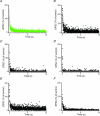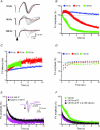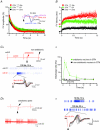Axonal failure during high frequency stimulation of rat subthalamic nucleus
- PMID: 21486784
- PMCID: PMC3112555
- DOI: 10.1113/jphysiol.2011.205807
Axonal failure during high frequency stimulation of rat subthalamic nucleus
Abstract
Deep brain stimulation (DBS) has been established as an effective surgical therapy for advanced Parkinson's disease (PD) and gains increasing acceptance for otherwise intractable neuropsychiatric diseases such as major depression or obsessive–compulsive disorders. In PD, DBS targets predominantly the subthalamic nucleus (STN) and relieves motor deficits only at high frequency (>100 Hz). In contrast to the well-documented clinical efficacy of DBS, its underlying principle remains enigmatic spawning a broad and, in part, contradictory spectrum of suggested synaptic and non-synaptic mechanisms within and outside STN. Here we focused on a crucial, but largely neglected issue in this controversy, namely the axonal propagation of DBS within and away from STN. In rat brain slices preserving STN projections to substantia nigra (SN) and entopeduncular nucleus (EP, the rodent equivalent of internal globus pallidus), STN-DBS disrupted synaptic excitation onto target neurons through an unexpected failure of axonal signalling. The rapid onset and, upon termination of DBS, recovery of this effect was highly reminiscent of the time course of DBS in the clinical setting. We propose that DBS-induced suppression of axonal projections from and to STN serves to shield basal ganglia circuitry from pathological activity arising in or amplified by this nucleus.
Figures






Similar articles
-
Axonal and synaptic failure suppress the transfer of firing rate oscillations, synchrony and information during high frequency deep brain stimulation.Neurobiol Dis. 2014 Feb;62:86-99. doi: 10.1016/j.nbd.2013.09.006. Epub 2013 Sep 16. Neurobiol Dis. 2014. PMID: 24051279 Free PMC article.
-
A continuous high frequency stimulation of the subthalamic nucleus determines a suppression of excitatory synaptic transmission in nigral dopaminergic neurons recorded in vitro.Exp Neurol. 2012 Jan;233(1):292-302. doi: 10.1016/j.expneurol.2011.10.018. Epub 2011 Oct 28. Exp Neurol. 2012. PMID: 22056941
-
Long-term plasticity of glutamatergic input from the subthalamic nucleus to the entopeduncular nucleus.Eur J Neurosci. 2018 Sep;48(5):2139-2151. doi: 10.1111/ejn.14105. Epub 2018 Aug 31. Eur J Neurosci. 2018. PMID: 30103273
-
Mechanisms of action underlying the efficacy of deep brain stimulation of the subthalamic nucleus in Parkinson's disease: central role of disease severity.Eur J Neurosci. 2019 Mar;49(6):805-816. doi: 10.1111/ejn.14088. Epub 2018 Aug 12. Eur J Neurosci. 2019. PMID: 30044030 Review.
-
An electrophysiological perspective on Parkinson's disease: symptomatic pathogenesis and therapeutic approaches.J Biomed Sci. 2021 Dec 9;28(1):85. doi: 10.1186/s12929-021-00781-z. J Biomed Sci. 2021. PMID: 34886870 Free PMC article. Review.
Cited by
-
Connectivity and Dynamics Underlying Synaptic Control of the Subthalamic Nucleus.J Neurosci. 2019 Mar 27;39(13):2470-2481. doi: 10.1523/JNEUROSCI.1642-18.2019. Epub 2019 Jan 30. J Neurosci. 2019. PMID: 30700533 Free PMC article.
-
Functional disconnection of axonal fibers generated by high frequency stimulation in the hippocampal CA1 region in-vivo.Brain Res. 2013 May 6;1509:32-42. doi: 10.1016/j.brainres.2013.02.048. Epub 2013 Mar 6. Brain Res. 2013. PMID: 23473842 Free PMC article.
-
Axonal Stimulations With a Higher Frequency Generate More Randomness in Neuronal Firing Rather Than Increase Firing Rates in Rat Hippocampus.Front Neurosci. 2018 Oct 24;12:783. doi: 10.3389/fnins.2018.00783. eCollection 2018. Front Neurosci. 2018. PMID: 30459545 Free PMC article.
-
Closing the loop of deep brain stimulation.Front Syst Neurosci. 2013 Dec 20;7:112. doi: 10.3389/fnsys.2013.00112. Front Syst Neurosci. 2013. PMID: 24391555 Free PMC article. Review.
-
Axonal and synaptic failure suppress the transfer of firing rate oscillations, synchrony and information during high frequency deep brain stimulation.Neurobiol Dis. 2014 Feb;62:86-99. doi: 10.1016/j.nbd.2013.09.006. Epub 2013 Sep 16. Neurobiol Dis. 2014. PMID: 24051279 Free PMC article.
References
-
- Ammari R, Lopez C, Bioulac B, Garcia L, Hammond C. Subthalamic nucleus evokes similar long lasting glutamatergic excitations in pallidal, entopeduncular and nigral neurons in the basal ganglia slice. Neuroscience. 2010;166:808–818. - PubMed
-
- Ammari R, Lopez C, Fiorentino H, Gonon F, Hammond C. A mouse juvenile or adult slice with preserved functional nigro-striatal dopaminergic neurons. Neuroscience. 2009;159:3–6. - PubMed
-
- Bekar L, Libionka W, Tian GF, Xu Q, Torres A, Wang X, Lovatt D, Williams E, Takano T, Schnermann J, Bakos R, Nedergaard M. Adenosine is crucial for deep brain stimulation-mediated attenuation of tremor. Nat Med. 2008;14:75–80. - PubMed
-
- Bellinger SC, Miyazawa G, Steinmetz PN. Submyelin potassium accumulation may functionally block subsets of local axons during deep brain stimulation: a modeling study. J Neural Eng. 2008;5:263–274. - PubMed
-
- Beurrier C, Ben-Ari Y, Hammond C. Preservation of the direct and indirect pathways in an in vitro preparation of the mouse basal ganglia. Neuroscience. 2006;140:77–86. - PubMed
MeSH terms
Substances
LinkOut - more resources
Full Text Sources
Miscellaneous

